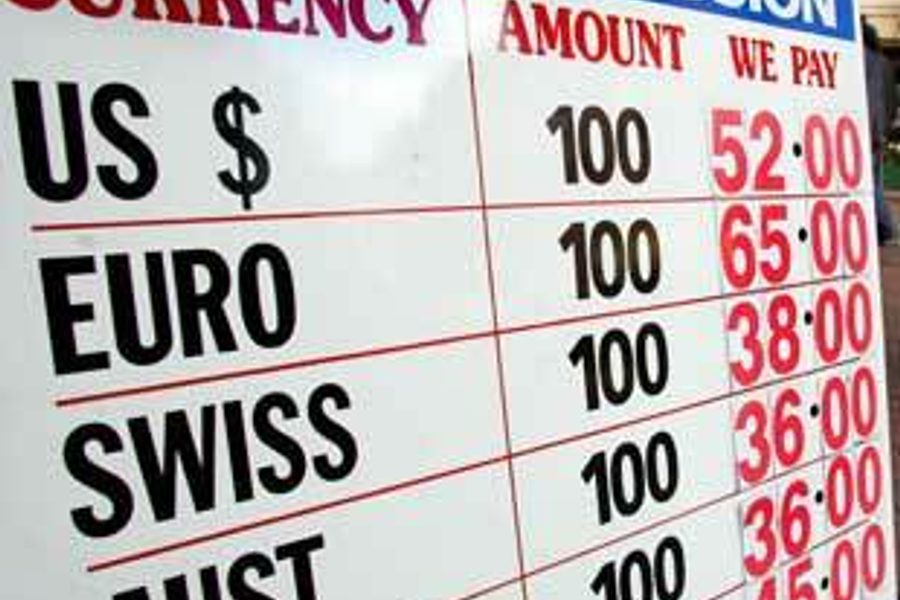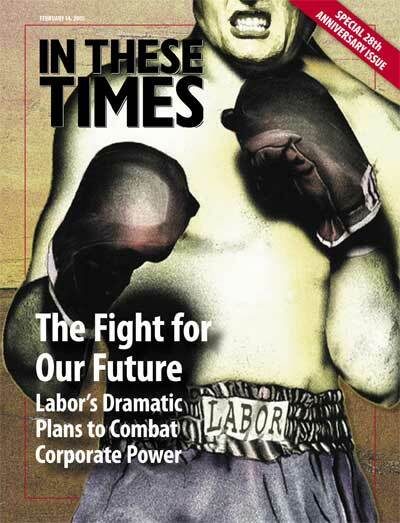
In the same way that men are prone to boast about the size of certain body parts, policymakers like to tout the merits of a strong dollar. While the former is usually harmless, promoting an overvalued dollar can be an incredibly destructive economic policy. Fortunately, the United States is moving away from its high dollar days, although not quickly enough, and not before vast damage has been done.
The value of the dollar is the main force equilibrating trade, keeping the value of imports in line with exports. When the value of the dollar rises, it makes U.S. exports more expensive to foreign buyers. For example, if the dollar rises by 30 percent against the euro, it will take 30 percent more euros for someone living in France or Germany to buy a computer or some other item produced in the United States. In this sense a rise in the dollar is equivalent to putting a tariff on U.S. exports — it makes them more expensive, and thereby reduces demand for U.S. exports.
The rise in the dollar has the opposite effect on imports coming into the United States. If it takes 30 percent fewer dollars to buy a euro, then items produced in Europe (e.g., German cars or French cheese) will theoretically cost 30 percent less in the United States. In this sense, a rise in the value of the dollar is equivalent to providing a subsidy for all goods imported into the United States. Therefore, the expected result of a high dollar is an increase in imports. (In reality, however, importers may not fully pass along to consumers the cost savings from a higher dollar in lower prices or the cost increases associated with a lower dollar in the form of higher prices.)
Unpleasant consequences
The United States deliberately embarked on a high dollar policy in 1995 when Robert Rubin took over as treasury secretary. Measured against the currencies of our trading partners, the dollar rose by 30 percent between 1995 and its peak in 2002. The rise in the dollar had exactly the effect predicted by standard economic theory — exports fell, and imports rose.
The high dollar policy has an important class dimension. The negative impact of the high dollar is felt by the sectors of the economy that most directly face foreign competition, primarily manufacturing and therefore manufacturing workers. The United States has lost more than 2.8 million manufacturing jobs since 1995, almost one-fifth of its total, largely because of the overvalued dollar. Furthermore, the loss of millions of jobs that offer relatively high wages for workers without college degrees has placed downward pressure on the wages of less-educated workers in general. In short, the high dollar has played an important role in redistributing income from less educated workers to highly educated professionals (e.g., doctors, lawyers and economists), who are largely protected from foreign competition.
The high dollar has caused the U.S. trade deficit to soar to unprecedented levels. In the third quarter of 2004 the current account deficit (the broadest measure of the trade deficit, which includes international income flows like interest payments and money sent home from immigrant workers) was running at an annual rate of $660 billion, or 5.6 percent of gross domestic product (GDP). Trade data for October and November indicate that the fourth quarter deficit will be even larger.
The current account deficit is similar to a budget deficit. The United States can run modest budget deficits (2 to 3 percent of GDP) indefinitely. It can also run large budget deficits for a short period of time, but it cannot run large budget deficits indefinitely. After a time, lenders become wary of the government’s ability to repay its debt, and they demand higher interest rates on government debt, such as treasury bonds, pushing up interest rates throughout the economy.
The current account deficit is financed by foreigners buying up U.S. financial assets. In the late ’90s the deficit was financed primarily by the willingness of foreign investors to buy into the stock bubble. When the stock market collapsed, many foreign investors started buying U.S. government bonds. But in the last year and a half, they have become less willing to buy government bonds — in part because of the fear of losing money on the falling dollar. Foreign central banks, in particular the central banks of Japan and China, have picked up the slack, buying up hundreds of billions of dollars’ worth of U.S. government debt in the last two years. This has temporarily sustained the value of the dollar and kept interest rates lower than they would be otherwise.
In the short term, the foreign central banks are helping support the U.S. economy, and therefore their own export markets. Without their support, the dollar would fall more sharply. This would lead to higher import prices, which would in turn lead to higher inflation as consumers and businesses are forced to spend more money for the same goods. Higher inflation would lead to higher interest rates on home mortgages and car loans, since investors typically expect that their return on loans will provide a premium above the rate of inflation. The resulting falloff in home and car sales will bring the already weak recovery to a quick end.
In the long run, however, relying on Japan and China to finance the U.S. budget deficit creates greater problems. Japan and China are under no obligation to pay U.S. consumers to buy their products (this is the effect of their current policy of buying up U.S. government bonds). They can just as easily pay anyone else to buy their products, including their own consumers. While Japan, China and other major exporters to the U.S. cannot develop new markets overnight, they certainly can develop alternative markets in the span of a few years. When these countries become less dependent on the U.S. market, they can dump their dollars any time they find it convenient. In the meantime, these countries are accumulating almost $2 billion a day, which may eventually be dumped on international financial markets.
It will not be pretty, but the best thing for the United States would be a quick fall in the dollar, which would provide a rapid correction in the trade deficit, by raising the price of imports and making our exports cheaper to people living in other countries. While this rise in import prices will result in higher inflation, there is no way that an increase in import prices can be avoided. The high dollar policy lets us live beyond our means in the short term by providing us with imports at extraordinarily low prices (just like a budget deficit lets us avoid taxing enough to pay for government spending), but we cannot indefinitely borrow money to import goods. It is best to reverse this high dollar policy and let the dollar fall before we accumulate even more debt and lose even more industry to foreign competition.
Cause vs. effect
Unfortunately, the media has largely clouded the policy debate over the dollar by confusing cause and effect. Numerous reporters have blamed the fall in the dollar on the current account deficit, which in turn is blamed on the budget deficit. While such stories rescue Robert Rubin’s reputation, they defy basic economic logic.
A budget deficit is supposed to lead to a current account deficit precisely because it raises the value of the dollar. According to the textbook story, a budget deficit raises interest rates, which in turn causes foreign investors to buy U.S. financial assets (higher interest rates makes U.S. assets more attractive to foreigners). When foreigners buy U.S. financial assets, the dollar rises, leading to a current account deficit. In other words, there is no way that a budget deficit can lead to the current account deficit, except through an overvalued dollar.
In short, this is one problem that cannot be blamed on President Bush — except in his failure to take steps to correct the imbalance earlier. The Clinton administration deliberately pushed a high dollar policy that, like the stock bubble, gave Americans a short-term illusion of prosperity, making imports cheap and keeping inflation low. Just as the inflated stock prices of the tech bubble could not be sustained indefinitely, it will be impossible to sustain the overvalued dollar for long. The return to reality will be painful, but the pain will only be greater the longer it is delayed.








